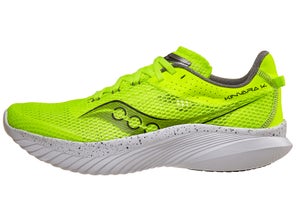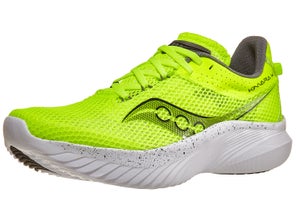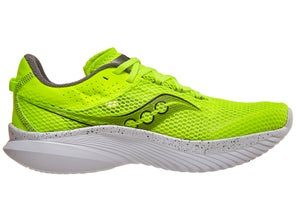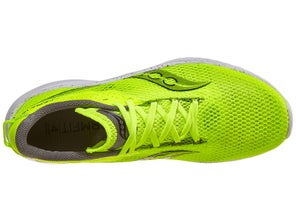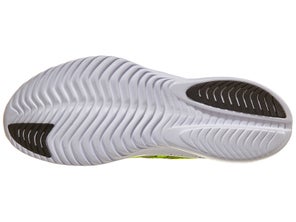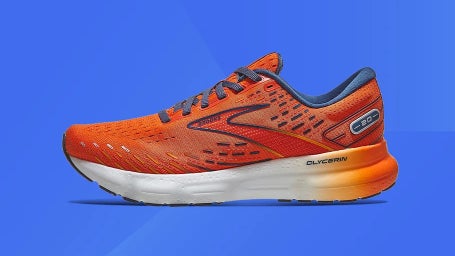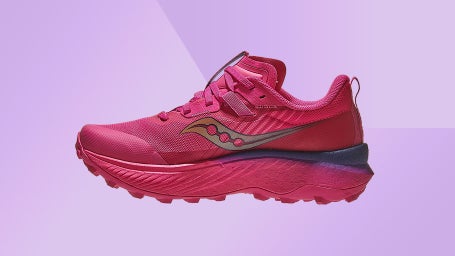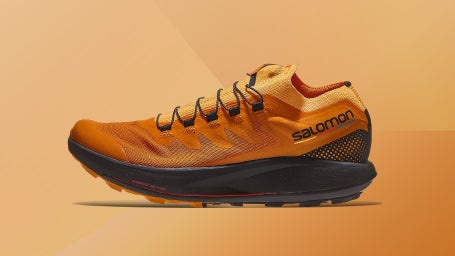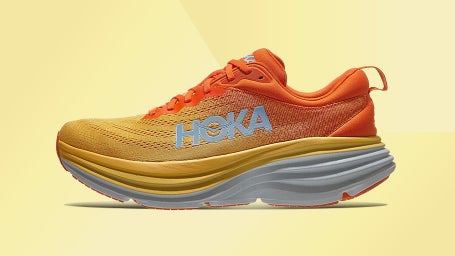
Saucony Kinvara 14 Review
Specifications & Fit
Shoe Specs
| Weight | Men's: 7.0 oz (size 9) | Women's: 6.2 oz (size 8) |
| Stack Height | 31 mm (Heel), 27 mm (Forefoot) | 4 mm Heel-Toe Offset |
| Terrain | Road |
| Stability | Neutral |
| Sizing | True to size |
Individual Thoughts

The Kinvara 14 is an excellent trainer for its value, delivering a lightweight feel with a well-cushioned, versatile ride. While some long-time Kinvara fans may miss the minimal underfoot feel of previous models, I enjoyed the Kinvara 14's medium level of cushioning. The rocker and low weight help me feel fast and nimble when I want to pick up the pace, but the Kinvara 14 is also protective enough to remain comfortable on long-distance runs. These shoes will not provide the same plush feel as a Saucony Triumph or HOKA Clifton, but they will keep you comfortable with their signature light-on-foot feel.
When picking up the pace, the PWRUN EVA foam firms up for a slightly responsive ride, but this works with the dramatic rocker to help make faster runs feel easy. At $200, I think the Kivara 14 makes a great training shoe for young athletes who are on a budget and for those who need one shoe for both daily training and speed workouts.
This version of the Kinvara might not be as good for cross-training as previous versions, but I still think it provides the level of versatility needed for gym workouts. I used it for a few HITT classes, lifting sessions, and treadmill runs, and I had no problems with the slightly higher stack height. Dedicated weight lifters will want to look elsewhere, but this will still be a good option for Crossfit athletes and those who frequent Orange Theory.
Our In-Depth Look
Upper
Liz: "I was really impressed with the Kinvara 14's upper. It is designed with a very lightweight and breathable mesh that somewhat reminds me of the Endorphin Pro 3's upper. I was concerned that this upper would be too race-like, but I was pleasantly surprised by how quickly it adapted to my feet, providing sufficient support for all my daily training runs.
My only issue with the upper was that the fit was on the snugger side. This was great for faster workouts, but I experienced some discomfort on runs longer than an hour. I have slightly wider feet, though, and I don't think runners with average or narrow feet will have any issues with fit."
Midsole
Liz: "I really enjoyed the Kinvara 14's balance of protective midsole cushioning and lightweight nimbleness. The midsole was soft enough to be comfortable on longer runs, while the well-crafted rocker geometry of the midsole helps make the ride feel smooth and efficient at faster paces.
The Kinvara 14's PWRUN foam midsole does not have the bouncy responsiveness of shoes like the Endorphin Speed. That said, it does deliver a more traditional responsiveness, keeping it from feeling sluggish even with the added cushioning underfoot."
Outsole
Liz: "The Kinvara 14 continues to feature an outsole of mostly exposed EVA. This will compromise some durability in the long run, but I was surprised by how little wear was visible after a month of testing. I was also impressed by the traction that the shoes provided. We have had an unusually wet few months, so many of my testing runs have been done in the rain or on wet pavement. I had no issues with traction or slipping, and I always felt confident in these shoes."
Comparable Models
Liz: "Considering its price and performance, the Kinvara is a somewhat niche offering. This is especially true now that it has gained a few more millimeters of stack height. The Saucony Endorphin Speed is another lightweight Saucony shoe that can handle daily training mileage and uptempo runs, but I prefer the Endorphin Speed's PWRRUN PB foam midsole as it delivers a much bouncier ride. That said, at $50 less, the Kinvara is an excellent option if you are looking for a versatile trainer for daily training runs, especially if you are a younger athlete or are more of a price-conscientious runner.
While it is no longer a minimally cushioned trainer, the Kinvara 14 still offers a lower-to-the-ground feel, especially when compared to shoes like the Endorphin Speed. I found the Kinvara to be a great option for cross-training and running.
A more comparable model in terms of price would be the New Balance Fuelcell Rebel v3. Both shoes have similar stack heights and are close in price, with the Rebel v3 listed at $220 and the Kinvara at $200. While both shoes are versatile enough to handle daily training mileage, the Rebel v3 feels more oriented toward faster runs. This is thanks to the Rebel's softer, more responsive FuelCell foam midsole, but some runners may find the Rebel less suitable for longer miles and everyday training than the Kinvara 14."
